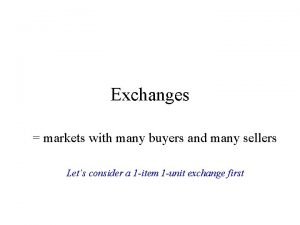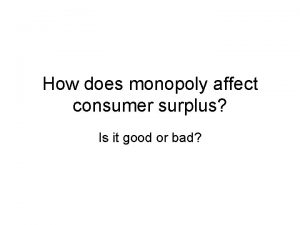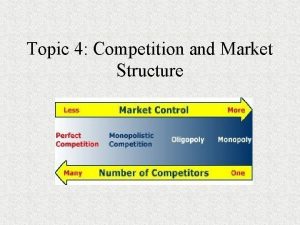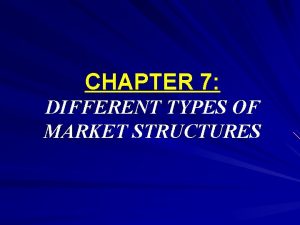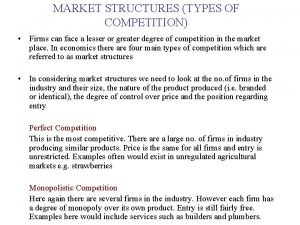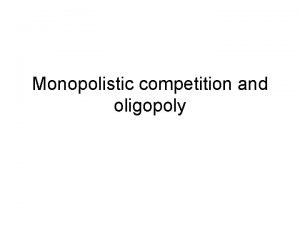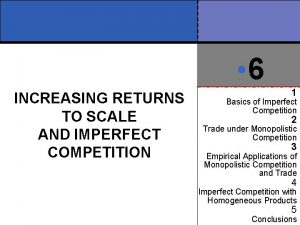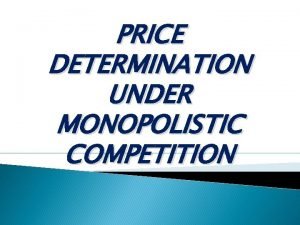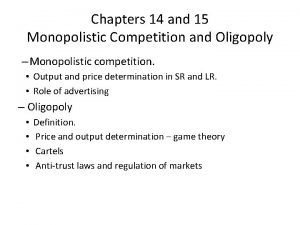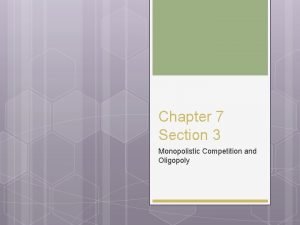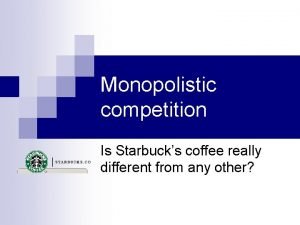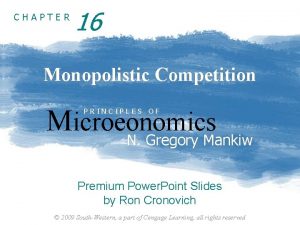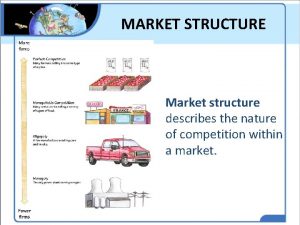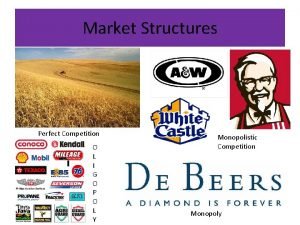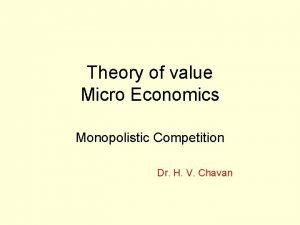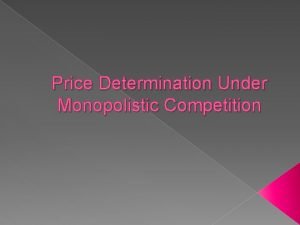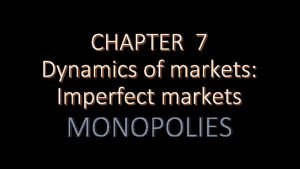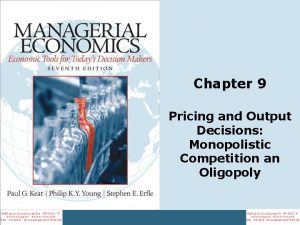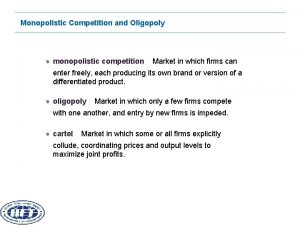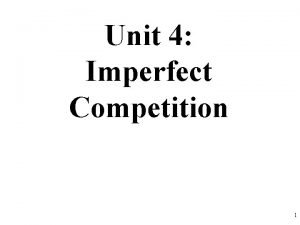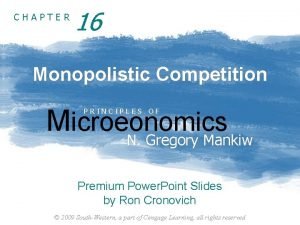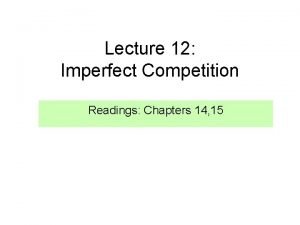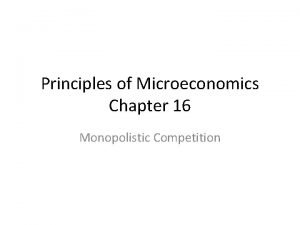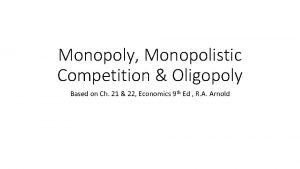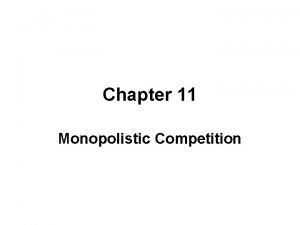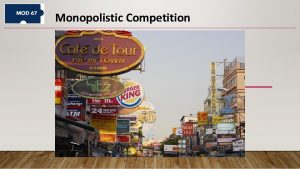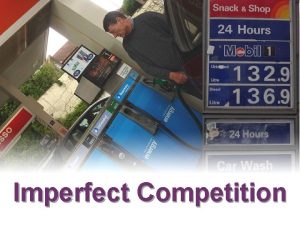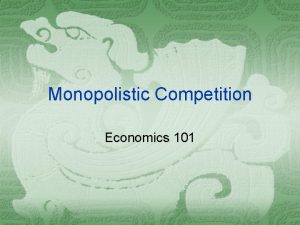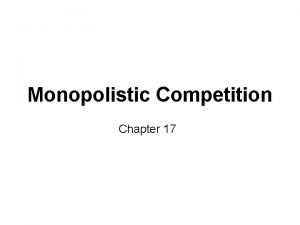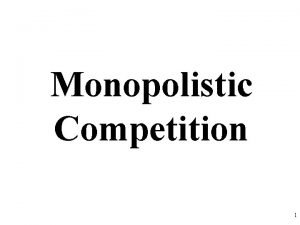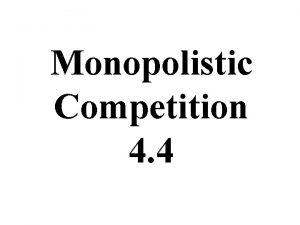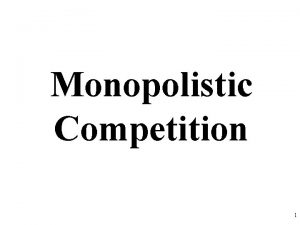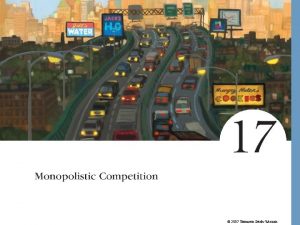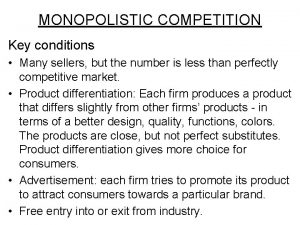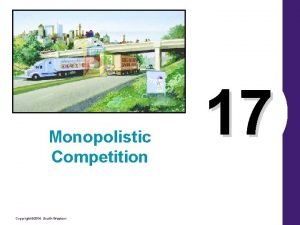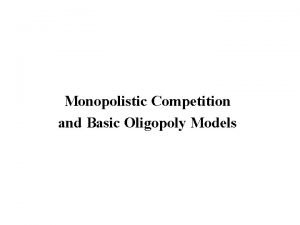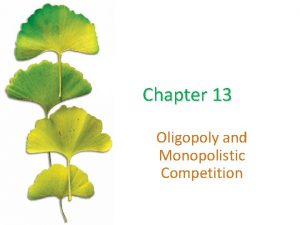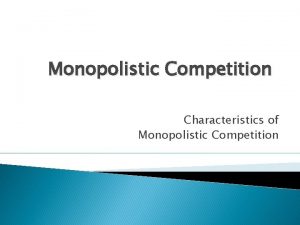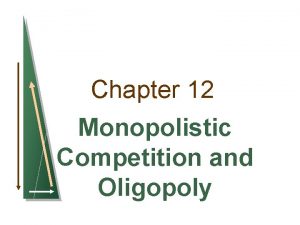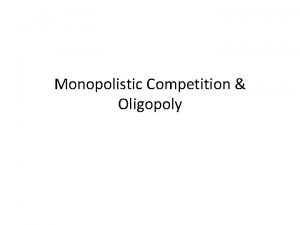Monopolistic Competition Monopolistic competition many sellers of similar
































- Slides: 32

Monopolistic Competition • Monopolistic competition – many sellers of similar products. • Since a monopolistic competitor sells a product that is different than its competitors, it will have some degree of market power.

Product Differentiation • Product differentiation – the process of distinguishing a firm’s product from similar products. • 1. to increase the firm’s market power. • See Examples 1 A and 1 B on page 23 -1. • 2. to increase the demand for the firm’s product. • See Example 2 on page 23 -1.

Demand Marginal Revenue • A monopolistic competitor faces a downward sloping demand curve, with the degree of slope depending largely on product differentiation. • See Examples 3 A and 3 B on page 23 -2. • The marginal revenue curve will be twice as steeply downward sloping as the demand curve.

Profit-Maximization • A monopolistic competitor will maximize profits by producing the quantity of output where MR = MC.

Profit-Maximization

Monopolistic Competition versus Perfect Competition • Compared to perfect competition, monopolistic competition results in less output at a higher price.

Perfect Competition

Monopolistic Competition

Economic Inefficiency • Monopolistic competition is economically inefficient. • Monopolistic competition results in a quantity of output where price exceeds marginal cost, and thus where MSB exceeds MSC.

Economic Inefficiency

Monopolistic Competition in the Long Run • In the long run, economic profits (or losses) are eliminated by firms entering (or exiting) the industry. • See Example 5 on page 23 -3.

Oligopoly • Oligopoly – an industry dominated by a few mutually interdependent firms. • See Example 6 on page 23 -4. • Oligopoly usually results from barriers to entry, especially economies of scale.

Theories of Oligopoly • 1. Kinked demand curve theory. • 2. Unkinked demand curve theory. • 3. Cartel theory.

Kinked Demand Curve Theory • Assumes that other firms will match a price reduction, but will not match a price increase. • The different response to an increase in price versus a decrease in price will cause the demand curve to be kinked at its current price and quantity.

Kinked Demand Curve

Marginal Revenue Curve • The kink in the demand curve will result in a gap in the marginal revenue curve.

Marginal Revenue Curve

Profit-Maximization • Profit-maximization will occur where the marginal cost curve passes through the gap in the marginal revenue curve.

Profit-Maximization

Kinked Demand Curve Theory • The gap in the marginal revenue curve means that a change in marginal cost may result in no change in price or quantity. • The kinked demand curve theory predicts “sticky” prices for an oligopoly.

Change in Marginal Cost

Unkinked Demand Curve Theory • According to economist George Stigler, there is no kink in the demand curve for an oligopoly. • Unkinked demand curve theory asserts that oligopoly is similar to monopolistic competition.

Cartel Theory • A cartel is an organization through which members jointly make decisions about prices and production. • See Example 9 on page 23 -6. • A cartel sets output for the industry, as would a monopoly, and allocates production to the member firms.

Maintaining a Cartel • Cartels are difficult to maintain due to: • 1. Noncartel competition. • See Example 10 on page 23 -7. • 2. The tendency of cartel members to “cheat” on the agreement. • See Example 11 on page 23 -7.

Economic Inefficiency • Oligopoly is economically inefficient. • Oligopoly results in a quantity of output where price exceeds marginal cost, and thus where MSB exceeds MSC.

Game Theory • Game theory – a method for analyzing strategic behavior. • See the “prisoners’ dilemma” game in Example 13 on page 23 -8.

Payoff Matrix

Dominant Strategy • Dominant strategy – a strategy that always yields the best result regardless of the strategies of the other players. • The dominant strategy for both Bo and Luke is to confess.

Nash Equilibrium • Nash equilibrium – the outcome when each game player has chosen their best strategy, assuming that all other players have chosen their best strategies. • The Nash equilibrium in a cartel is for all members of the cartel to “cheat”. • See Example 14 on page 23 -9.

The NCAA Cartel • The NCAA is a buying cartel. • Its members have agreed to a maximum price for college athletes. • The big-revenue college sports can generate millions of dollars in revenue. • See Example 16 on page 23 -9.

The NCAA Cartel • As a result of the NCAA cartel, income is redistributed from the athletes in the bigrevenue sports to the athletic departments. • See Example 18 on page 23 -10.

The NCAA Cartel • As a cartel, the NCAA faces noncartel competition from the NFL and the NBA. • And there is a strong tendency for NCAA members to “cheat” on the cartel agreement. • See Example 19 on page 23 -10.
 Many sellers many buyers
Many sellers many buyers Many sellers and many buyers
Many sellers and many buyers Pure competition vs monopolistic competition venn diagram
Pure competition vs monopolistic competition venn diagram Perfect competition vs monopolistic competition
Perfect competition vs monopolistic competition Lump sum subsidy monopoly
Lump sum subsidy monopoly Monopoly vs monopolistic competition
Monopoly vs monopolistic competition Consumer surplus in monopolistic competition
Consumer surplus in monopolistic competition Monopolistic competition pictures
Monopolistic competition pictures Def of monopolistic competition
Def of monopolistic competition Monopoly business examples
Monopoly business examples Monopolistic competition in long run
Monopolistic competition in long run Monopolistic competition example
Monopolistic competition example Monopolistic competition
Monopolistic competition Monopolistic competition characteristics
Monopolistic competition characteristics Price determination under monopoly
Price determination under monopoly Characteristics of monopolistic competition
Characteristics of monopolistic competition Chapter 7 section 3 monopolistic competition and oligopoly
Chapter 7 section 3 monopolistic competition and oligopoly Is starbucks an oligopoly
Is starbucks an oligopoly Monopolistic competition characteristics
Monopolistic competition characteristics Market structure
Market structure Differentiate between perfect competition and monopoly
Differentiate between perfect competition and monopoly Monopolistic competition short run
Monopolistic competition short run Price determination under monopolistic competition
Price determination under monopolistic competition Difference between perfect competition and monopoly market
Difference between perfect competition and monopoly market Example of pure competition
Example of pure competition Monopolistic competition price
Monopolistic competition price How to find excess capacity on a graph
How to find excess capacity on a graph Characteristics of monopoly
Characteristics of monopoly Conclusion
Conclusion Monopolistic competition short run
Monopolistic competition short run Chapter 16 monopolistic competition
Chapter 16 monopolistic competition Consumer surplus in monopolistic competition
Consumer surplus in monopolistic competition Monopolistic competition feature
Monopolistic competition feature

